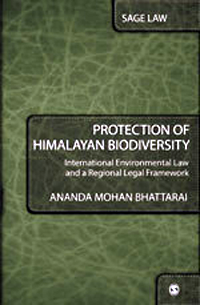Apr 19, 2024
Apr 19, 2024
 Biodiversity refers to the variety of life forms that are found on earth. It has been found that there are certain regions on earth where biodiversity is very high. These are referred to as biodiversity hotspots holding especially high numbers of endemic species. As everyone knows, the Himalayas have the world’s tallest mountains. A diversity of ecosystems may be found in the Himalayas and it is no wonder that one of the world’s biodiversity hotspots are the Himalayas. The Himalayan region has been settled for thousands of years and over time, the relationship between humans and nature has developed carefully, steadily. A tremendous base of traditional knowledge about the various plant species present here exists, regarding the multifarious uses as well as methods of conservation. This is under threat from a variety of causes, from simple deforestation to complex issues such as incorrect policy which may have impact at the social level as well.
Biodiversity refers to the variety of life forms that are found on earth. It has been found that there are certain regions on earth where biodiversity is very high. These are referred to as biodiversity hotspots holding especially high numbers of endemic species. As everyone knows, the Himalayas have the world’s tallest mountains. A diversity of ecosystems may be found in the Himalayas and it is no wonder that one of the world’s biodiversity hotspots are the Himalayas. The Himalayan region has been settled for thousands of years and over time, the relationship between humans and nature has developed carefully, steadily. A tremendous base of traditional knowledge about the various plant species present here exists, regarding the multifarious uses as well as methods of conservation. This is under threat from a variety of causes, from simple deforestation to complex issues such as incorrect policy which may have impact at the social level as well.
Biodiversity is protected at multiple levels – at the international level we have the Convention on Biodiversity (CBD) and the Convention on International Trade in Endangered Species (CITES), for example. At the national level there are various laws regarding protection of forests and biodiversity. The relation between these various instruments, their evolution and implementation is complex. This well produced book, written by a Judge in the Court of Appeal in Nepal takes a detailed look at the various laws and policies regarding the protection especially of Himalayan biodiversity. Divided into six major chapters followed by concluding observations, the book opens with an introduction to the Himalayan region with specific reference to its geology, ecology and anthropology. Most important here is the coverage of the issues that plague this region of which the constraints in the life of these people, so dependent on nature for their livelihoods, are clearly explained. The vastness of the region means that the problems cannot be easily generalized. The next chapter discusses the CBD and the focus on Mountain Biodiversity the emerged during COP VII when a Programme of Work was endorsed.
One of the key objectives of the CBD is the fair and equitable sharing of benefits arising from genetic resources. This in fact was the subject of the Nagoya Protocol, adopted at CBD’s tenth COP in December 2010. Today, there are an increasing number of drugs and other chemicals being derived from natural plant products. In many cases, the information has been derived from traditional knowledge about the properties of certain plants. Two examples about access to genetic resources and benefit-sharing are given, namely those of Cameroon and Costa Rica. Perhaps an example from closer home, that of the Kani tribals, could also have been provided. The other major area, also closely related in some ways, is the protection of traditional knowledge. Guidelines have been developed for this, but the extent of ‘biopiracy’ based on lesser documented knowledge must be quite considerable going by the discussion on some well known cases such as neem and turmeric. The relationship between Intellectual Property Rights (IPR) and biodiversity has been difficult. Can one patent life or life forms? The debate goes on and Bhattarai’s logical discussions make compulsive reading.
In the penultimate chapter of the book, the author has outlined a possible way forward for the protection of Himalayan biodiversity. Bringing in his considerable experience, he systematically spells out the existing gaps, the problems and challenges, the areas that must be covered, the principles that would be relevant to the process and the way forward. He points out that the definitions need to be clear and unambiguous and the way negotiations need to be carried out. At the very end, he talks about (economically) valuing ecosystems – this indeed is the latest mantra in our crusade to save earth’s biodiversity. All in all, a book that abounds in clear thinking and scholarship and a must-read for those who are working on issues related to biodiversity though even an interested layperson will easily understand as (s)he reads through.
29-May-2011
More by : Dr. Ahana Lakshmi

|
Hi there. I'm a high school student doing a science project on hotpots in the Himalayas. One of our tasks is contact someone who knows about the topic. Is there any chance you're willing to be our contact? If so, please email me at 02chano@aisgz.org. Thank you! Annie Chan |